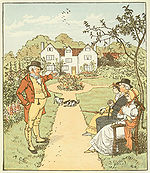Learning Commons:Chapman Learning Commons/Cite Images
Overview
The bare minimum citation requirement as stipulated in the Copyright Act only includes the source of the material used and, if available, the name of the creator (i.e. Creator, Source). While there is no legal requirement to attribute works in the public domain to their creator(s), doing so is an important part of maintaining academic integrity. However, generally, media citations (whether they are in the public domain or not) should meet the same requirements as a text citation; that is, a reader should be able to find the source of the image, and the image itself, based on the information in the citation.
In most cases, there is enough information to cite a piece of media beyond the minimum requirement. Sometimes the copyright holder will specify a particular citation style, or that certain information be included, and some citation styles (such as APA or MLA) will require additional information in the citation. Examples of where permission requirements explicitly go beyond the minimum copyright requirements are: creative commons licenses, individual use agreements, and licensed databases.
In this resource we will discuss examples of how to cite various forms of media, but please refer to the citation practices of your discipline for specific details not covered in this guide.
Creative Commons Images
Creative Commons licenses are a variety of licenses that facilitate the sharing and reuse of information and creative works. There are many different Creative Commons licenses and each allows the work to be shared and reused in different ways. Not all images available under Creative Commons licenses are available for all uses.
All Creative Commons (CC) licences require the image user to attribute the creator of the image, but how that attribution can be provided is flexible depending on the type of licence and the medium in which the image is being used. Depending on where the image will be used different citation formats are necessary to convey all the required information. In an online environment, hyperlinks can be used to minimize the length of the image citation; in a print resource the citation will be longer because all the required information must be written out in full.
For a detailed guide to attributing creative commons material see our dedicated resource, Use Creative Commons Media.
Online Media Databases
Online image databases are sites such as Flickr, Wikimedia Commons, or Getty Images. Some of them are free to use (Flickr) and some are commercial (Getty). The attribution or citation required depends on the individual database. Each database should have a terms of use or copyright statement laying out what is and is not permissible to do with the images in their collection and how the images should be attributed.
Databases with Creative Commons Licenses
Many of the free databases, like Flickr and Wikimedia Commons, use Creative Commons (CC) licenses to make the images available for reuse. In some cases, all images uploaded to the database are available under the same CC license; in other cases, it is up to the creator/ uploader to specify which type of CC license will be applied to each image. It is the creator, not the database owner, who retains copyright to the image. If you are using an image with a CC license from an online database, follow the attribution requirements specified by the CC license and the image creator. (See our Use Creative Commons Media resource for more information on citing CC images.)
Individual Use Agreements
Take a look at this example. It exists on Flickr, where many (but not all) works are available through some level of Creative Commons use, but this specific image states that all rights are reserved to the copyright holder — meaning, it is not free to use in any capacity (note that it is not reproduced here, for that specific reason).
Sometimes you will find these instances even if you’re doing your best to search for only Creative Commons images, so be careful and pay attention to the specific work’s details/description, just in case, when you use content from elsewhere.
Databases with individual licenses or permission statements
If the database does not use creative commons licenses but the images are still available for free, check the terms of use (or copyright/permissions) section of the database for citation requirements. Some databases, such as those created by institutions, have a general guideline for how to attribute the media listed on their database — we will be calling those Licensed Databases.
If there are no citation requirements specified by the database then the general rule of "creator, title, source" applies. In this case, the URL to the database site or the individual image page would be the best way to attribute the source of your media, although just the name of the database (ie: Flickr) would be sufficient for Copyright Act standards. Reference style guides, such as APA, MLA, or AMA, may have more detailed citation requirements; consult the appropriate style guide if you are following a particular style in your work. You can find more information about your citation style on our dedicated resource, Cite Sources.
What Do Database Licenses Look Like?
One example of a database with an individual license is the Imperial War Museum. They make most of their digital collection freely available for non-commercial uses. However, under their Non-Commercial Licence it states that image users must "acknowledge the source of the information by including any attribution statements specified by IWM and any other third parties ( © ......) and where possible, provide a link to this licence."

Additionally, on the details page for each image, it is specified whether the image is available under the IWM Non-Commercial Licence, and specifies the terms for the image’s citation:
"By downloading any images or embedding any media, you agree to the terms and conditions of the IWM Non Commercial Licence, including your use of the attribution statement specified by IWM. For this item, that is: © IWM (Q 1069)"
Based on their license agreement, we would cite this image in a caption as you see on the right.
Citation Examples of Licensed Database Works
At a minimum, the image citation should include: Creator, Image title: Source. Many publication style manuals, including APA and MLA, have more specific and detailed requirements for citing images from digital databases. Some style guides make a distinction between media that are copies of physical art and media that exist only in a digital format. Refer to the citation practices specific to your discipline if you are following a particular citation style. Below are a few examples of APA and MLA style.
Minimum Citation:
Creator, Title: Source.
Edouard Manet, A Bar at the Folies-Bergere: ARTstor Digital Library.
APA 7th Edition Citation Template:
- Creator's last name, first initial. (Date of creation). Title of image [Type of work]. Database name. URL
- Manet, E. (1882). A bar at the Folies-Bergere [Image of painting]. ARTstor Digital Library. https://library-artstor-org.ezproxy.library.ubc.ca/#/asset/ACOURTAULDIG_10313599356
MLA 8th Edition Citation Template:
- Digital copy of an item in a physical collection:
- Creator's last name, first name. Title of Image. Year of creation. Physical collection. Title of database, URL.
- Manet, Edourard. A Bar at the Folies-Bergere. 1882. Courtauld Institute Galleries, London. ARTstor Digital Library, https://library-artstor-org.ezproxy.library.ubc.ca/#/asset/ACOURTAULDIG_10313599356.
- Digital image only:
- Creator's last name, first name. Title of image. Year of creation. Title of website or database, URL.
- Towell, Larry. Ann Towell Watching Business Fax. 1995. ARTstor Digital Library, https://library-artstor-org.ezproxy.library.ubc.ca/#/asset/AMAGNUMIG_10311515794.
Websites
Citing images from a website is very similar to citing images form online image databases. Check the website's terms of use (or copyright/ permissions section) to determine if the image is available for use and for any specific attribution requirements. If no specific attribution requirements are indicated then the standard "creator, title, source" (with the source being a URL to the image webpage) applies.
Note: Many websites and blogs use others' materials without permission. When considering using an image from a website, double check the website owner is the copyright holder, or has permission to use and share that image. It is not always easy to identify who is the true copyright holder of an image so use your judgment. Is it reasonable to assume the website owner is the image copyright owner? If you want to be extra diligent, you can use Reverse Image Search engines (such as Tineye) to determine whether the image is from a different source.
Print and Electronic Publications
A citation for an image from a published source requires, at minimum, the creator of the image and the source of the media. It is good practice to also include the image title. The general format would be: Creator, Title, source.
How the source of the media is cited depends on the citation practices of the discipline. For example citing an image from a journal source, an image citation in APA (7th edition) and MLA (8th edition) would look like this:
APA 7th Edition Citation Template:
Creator (Last name, First Initial), Title. From Author(s). (Year of publication). Article title. Journal Title, volume number(issue number), pages.
MLA 8th Edition Citation Template:
Creator (Last name, First Name), Title. From Author(s). "Title of Article." Title of Journal, Volume, Issue, Year of Creation, pages.
Examples (APA Style):
Short Citations
If including the full reference directly under the image is not appropriate for the project it is possible to include a short attribution under the image with a full citation or attribution statement in a reference page at the end of the work or in a footnote, much like an in-text citation.
Other Media
While each respective citation style has more detailed information on how to cite various forms of media and content (you can find resources for citation on our Cite Sources resource guide), here we have compiled some examples of common types of media and their citations in MLA 8th edition and APA 7th edition.

MLA 8th Edition Citation Template:
- In-Text Citation: (@username) e.g. (@UBC Learn)
- @username. “Entire tweet typed in quotation marks.” Twitter, day Mon. year, time, URL.
- @UBClearn. “Do you ever get nervous about making an unavoidable call on the phone? Here are some tips to help ease your phone phobia!” Twitter, 3 July 2020, 12:00 p.m., https://twitter.com/UBCLearn/status/1279127937510498304.
APA 7th Edition Citation Template:
- In-Text Citation: (Last name, Year) e.g. (Chapman Learning Commons, 2020)
- Last name, F. M. Or name of group [@username]. (Year, Month Date). Content of the post up to the first 20 words [Tweet; any additional content information]. Twitter. URL
- Chapman Learning Commons [@UBClearn]. (2020, July 3). Do you ever get nervous about making an unavoidable call on the phone? Here are some tips to help ease [Tweet; thumbnail link to article]. Twitter. https://twitter.com/UBCLearn/status/1279127937510498304
YouTube

MLA 8th Edition Citation Template:
- In-Text Citation: (First item appearing in full citation) e.g. ("Pay for Print - Add money and web print"), (Veitch)
- Author’s last name, first name. “Video title.” YouTube, uploaded by Uploader, day Mon. year, URL.
- *If the author and the uploader are the same, only cite the author once as the uploader.
- “Pay for Print - Add money and web print.” YouTube, uploaded by UBC Learn, 27 Feb 2019, https://www.youtube.com/watch?v=u934lsNHQds.
- Veitch, James. “This is what happens when you reply to spam email.” YouTube, uploaded by TED, 1 Feb 2016, https://www.youtube.com/watch?v=_QdPW8JrYzQ.
APA 7th Edition Citation Template:
- In-Text Citation: (Last name, Year) OR (Username, Year) e.g. (UBC Learn, 2020)
- Last Name, F. M. OR Screen Name. (Year, Month Date). Title of video [Video]. Streaming Service. URL
- UBC Learn. (2020, April 23). Studying at home: CLCA diary video [Video]. YouTube. https://www.youtube.com/watch?v=KcJ9BTsRpks
Movie/TV Shows
Episode of a Show
MLA 8th Edition Citation Template:
- In-Text Citation: ("Title of Episode") e.g. ("Diversity Day")
- “Title of Episode.” Show Name, season number, episode number, network, day Month year. Platform, URL.
- “Diversity Day.” The Office, season 1, episode 2, NBC, 24 March 2005. Netflix, https://www.netflix.com/watch/70069628.
APA 7th Edition Citation Template:
- In-Text Citation: (Episode Writer Last name, Year) e.g. (Korsh, 2019)
- Episode Writer, W. W. (Writer), & Episode Director, D. D. (Director). (Original air date). Title of episode (Season number, Episode number) [Tv series episode]. In P. Executive Producer (Executive Producer), Series title. Production company(s).
- Korsh, A. (Writer & Director). (2019, September 25). One last con (Season 9, Episode 10) [TV series episode]. In D. Liman & D. Bartis (Executive Producers), Suits. Untitled Korsh Company; Universal Content Productions; Open 4 Business Productions.
Entire TV series
MLA 8th Edition Citation Template:
- In-Text Citation: (Last name(s)) e.g. (Daniels and Schur)
- Last name, first name, creators. Show Title. Production Company, Year.
- Daniels, Greg and Michael Schur, creators. Parks and Recreation. Deedle-Dee Productions and Universal Media Studios, 2015.
APA 7th Edition Citation Template:
- In-Text Citation: (Executive Producer Last name, Year) e.g. (Sherman-Palladino et al., 2017-present)
- Executive Producer, P. P. (Executive Producer). (Date range of release). Title of series [TV series]. Production company(s).
- Sherman-Palladino, A., & Palladino, D. (Executive Producers). (2017-present). The Marvelous Mrs. Maisel [TV series]. Dorothy Parker Drank Here Productions; Picrow, Amazon Studios.
Full Movie
MLA 8th Edition Citation Template:
- In-Text Citation: (Title of Film) e.g. (Speed Racer)
- Title of Film. Directed by First Name Last Name, Film Studio/Distributor, Release Year.
- *If relevant, list performer names after the director's name.
- Speed Racer. Directed by Lana Wachowski and Lilly Wachowski, performances by Emile Hirsch, Nicholas Elia, Susan Sarandon, Ariel Winter, and John Goodman, Warner Brothers, 2008.
APA 7th Edition Citation Template:
- In-Text Citation: (Last name, Year) e.g. (Loyd, 2008)
- Director, D. D. (Director). (Date of publication). Title of motion picture [Film]. Production company.
- Loyd, P. (Director). (2008). Mamma mia! [Film]. Universal Pictures.
Podcasts

MLA 8th Edition Citation Template:
- In-Text Citation: ("Title of Episode") e.g. ("38 - Decision Making: Does Stress Recovery Exist?")
- “Title of Episode.” Podcast Name from Distributor, day Mon. year of release, URL.
- “38 - Decision Making: Does Stress Recovery Exist?” In[Tuition] from PodBean, 17 Dec. 2018, https://intuitionpod.podbean.com/e/decision-making-does-stress-recovery-exist/.
APA 7th Edition Citation Template:
- In-Text Citation: (Host OR Executive Producer) e.g. (Prime)
- Host, A. A. (Host). (Year, Month Date). Title of episode (No. if provided) [Audio podcast episode]. In Name of podcast. Publisher. URL
- *Instead of the host you can also list the executive producer.
- *If you used an App instead of a browser to access the podcast, omit the URL.
- Prime, K. (Host). (2019, March 29). For whom the cowbell tolls [Audio podcast episode]. In Radiolab. WNYC Studios. https://www.wnycstudios.org/story/whom-cowbell-tolls
Song
MLA 8th Edition Citation Template:
- In-Text Citation: (Artist First Name Last Name) e.g. (Rae Morris)
- Artist First Name Last Name. “Song Title.” Album Name, Record Company, Release Year. Platform, URL.
- Rae Morris. “Skin.” Cold, Atlantic Records, 2014. Spotify, open.spotify.com/track/0OPES3Tw5r86O6fudK8gxi.
APA 7th Edition Citation Template:
- In-Text Citation: (Artist Last Name) e.g. (Dracus)
- Artist Last name, F. (Year of release). Title of song [Song]. On Title of album [Album]. Record label.
- Dacus, L. (2018). Night shift [Song]. On Historian [Album]. Matador Records.

